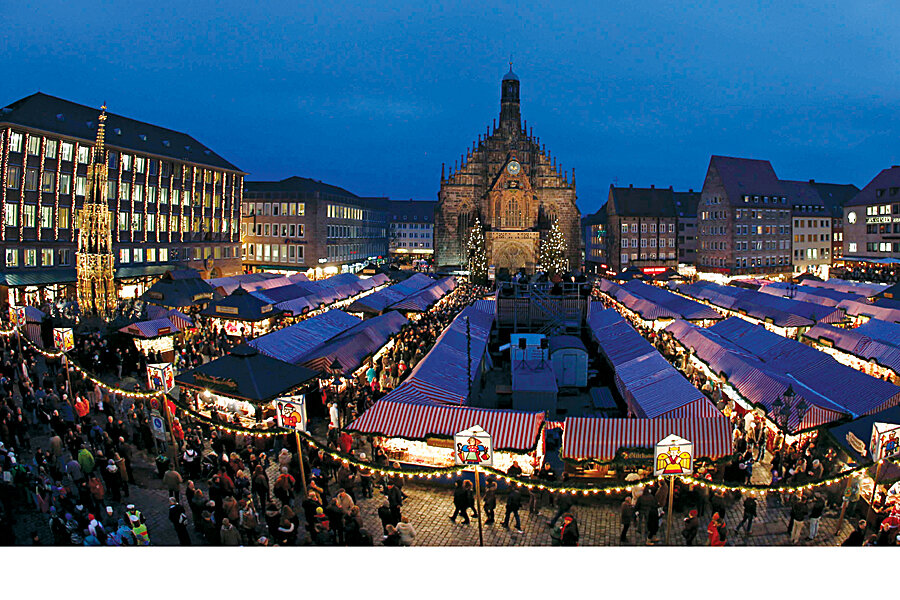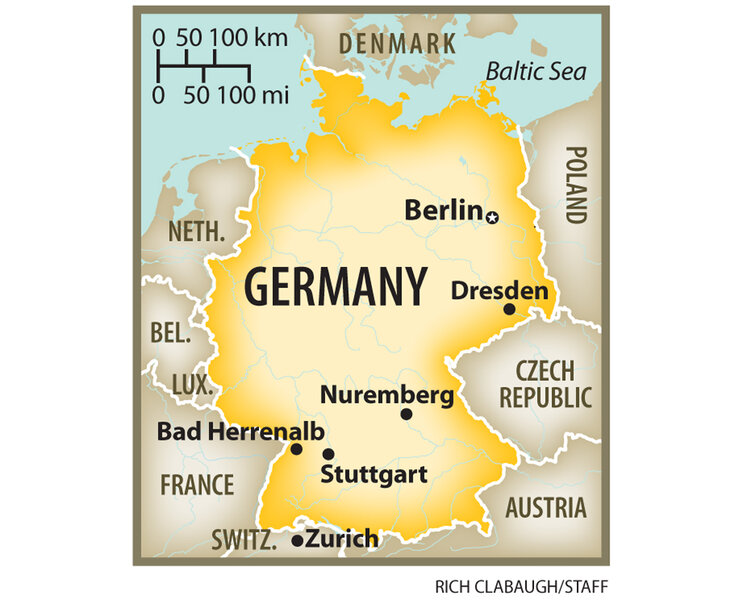The German roots of Christmas
Loading...
| Stuttgart and Bad Herrenalb, Germany
The sun is starting to dip when Hagen and Renate Wotzel peer into a pine-trimmed wooden stall laden with Christmas tree ornaments – hand-carved nutcrackers, rocking horses, and simple snowflakes and stars.
Just as in years past, the aroma of cinnamon, smoked fish, and sizzling bratwurst fills the crisp air. Ms. Wotzel, a retired teacher wearing a thick, white knitted headband covering her ears, digs out her purchase: candles made of rolled honeycomb. They are as ubiquitous and predictable as the homemade decorations, handmade fingernail brushes, and gingerbread cookies iced with kitschy pictures of Santa Claus or pastel letters reading "I love you" in German that make up the goods on sale here each December.
The couple knew what wares would be on offer. They have visited the Christkindlmarkt, or Christmas market, in Stuttgart, Germany, their entire lives, just as their ancestors did beginning in 1692, the market's first recorded reference. But that's the point. This night serves a different purpose: a chance to, literally, step into the spirit of the Christmas season and take the time to experience and recall an older era.
"The Christmas market reminds me of what Christmas was like when I was a child, when it was not so developed or commercial," says Mr. Wotzel, a retired engineer in a woolen beret. "It brings me back to those child's dreams."
And indeed, as the sun sets, white lights begin to twinkle, turning the more than 280 wooden huts, a Ferris wheel and merry-go-round, and the historic buildings of Old Town Stuttgart into a Christmas fairyland. A women's a capella group sings hymns in Latin. Toddlers squeal as a steam engine carries them across old Germanic towns in miniature. If any place represents the iconic "traditional" concept of Christmas, it is right here, in this moment, in December in Stuttgart.
Yearning for tradition
Many of the longest-held traditions celebrated at Christmas have their origins in German-speaking Europe, from the Christmas tree to the rituals of decoration to Advent calendars and gingerbread houses. Today, it is the Christmas market that is spreading. There are thousands of such markets across Germany each December, from big-city events like Stuttgart's – expected to attract 4 million visitors this season – to the quaint celebration of Bad Herrenalb, a village of just 7,000 in a valley of the Black Forest. And they've been exported across the continent and the Atlantic to the United States – where the Christmas season brings with it two ongoing debates: whether government inclusivity and secularism are fueling a "war on Christmas," and whether Christmas is being hyper-commercialized and devalued.
But here, at a German Christmas market, there is nothing self-conscious or apologetic, or particularly harried. This is unmistakably Christmas, in all its peaceful glory.
For artisans and shoppers alike, partaking in rituals of the past, be they religious or just cultural, would have resonance in 2013. For a European today, it's a time of increased immigration, diversity, and consequent tensions. Even the European Union, which once seemed as much a certainty to the postwar European as democracy or religion itself, is constantly questioned. Yet Stephen Nissenbaum, author of Pulitzer Prize finalist "The Battle for Christmas," says this yearning for a quainter, more authentic, and less consumer-driven time is not necessarily unique to Europeans today. It is, in fact, one of the most dominant and deepest-rooted feelings of Christmas as we know it.
"People have always been looking for something real in a changing modern world," Mr. Nissenbaum says. "People have been feeling that and saying that at least since the 1830s."
A pagan history
It might seem ironic that so many of the Christmas traditions today considered "authentic" have their roots in pagan rituals that predate Christianity – and were, for centuries, rejected by churchmen and women.
The traditions that emerged in ancient northern European societies had their founding as midwinter festivities that marked the winter solstice and the end of the agricultural cycle. They prevailed from generation to generation because of the power of the season: The longest nights of the year demanded respites, and because the harvest was over, there was bounty and downtime enough to celebrate – often raucously.
"It is hard for us to imagine the power of that darkness now, when we are used to switching on switches and getting rid of it," Nissenbaum says.
Christmas is not mentioned in the Bible, nor is Dec. 25 referred to as the day of Christ Jesus' birth. The holiday itself wasn't embraced by Rome until the 4th century. But because of its partylike beginnings, it was rejected by many Protestant churches. The Puritans in New England considered Christmas a sin, putting it on a black list with cards and dice. It was actually outlawed in Boston, with anyone celebrating it fined five shillings, in what might be considered the first "war on Christmas."
It was not until the mid-18th century that the holiday was socially accepted in the US – and not until the 1830s that it was "domesticated" to become the holiday that we recognize today.
Popular in their simplicity
Nestled in a valley at the upper edge of Germany's Black Forest, Bad Herrenalb is postcard pretty, with half-timbered homes set in pine-covered hills. Fog sets in each morning, mingling with the smoke of chimneys. The market here is a fraction of what is on display in Stuttgart. Through the archways of the town center, decorated with shooting-star wreaths of pine, a few dozen stalls sell local schnapps, ornaments, and bags of wool. Santa faces painted on cut timber peer out from parks and private homes at visitors across the town.
Thomas Frey, a father of four selling handmade wooden toys and ornaments at the Christmas market of Bad Herrenalb for local Scout groups, is proud of the German way of celebrating Christmas, a more solemn affair that he says is illustrated even in the music. If "Stille Nacht," or "Silent Night," characterizes the mood here, in the US it's "Jingle Bells." "I have the idea that Coca-Cola forms the way Christmas is celebrated in the US," he says.
And he adds that if shopping malls epitomize Christmas shopping in some countries – and he himself has to go to one for the electric parts that his 11-year-old wants for his train – the Christkindlmarkt is the essence of what German Christmas is about: simple crafts, made by hand. Nothing mass-produced in China here.
It's an appeal that has crossed Germany's borders: Mr. Frey has been asked to go to Paris 10 times to sell his goods. And foreigners flood to Germany, where the Christmas market is indeed booming. The majority are like the one in Bad Herrenalb, two-day affairs that are primarily for locals. But big-city markets can last for weeks, opening the last weekend in November and some closing after New Year's Day. They draw in busloads of tourists, from neighboring Switzerland to China.
The market in Nuremberg, the country's most famous, draws about 2 million visitors each year. The market in Dresden, the nation's oldest, celebrating its 579th anniversary this year, now boasts 11 separate markets.
"While a few are expressing concern that markets multiply, that they are getting bigger and start too early, the vast majority seem to love the markets," says Manfred Becker-Huberti, a German expert on Christmas.
No 'war on Christmas'
One is Yvonne Irminger, who makes the journey to Stuttgart from her native Zurich, Switzerland, each year with her mother and a friend. The trio have been doing so for more than a decade. Even though Zurich has a Christmas market, displaying one of the tallest Christmas trees in the world – and decorated with 7,000 Swarovski crystal ornaments, Ms. Irminger says she is drawn to the simplicity at a German market, and the fact that there are no knickknacks that can be purchased at any time, anywhere.
"We have it at home, but here there is a culture to it; it is more authentic," Irminger says. The women laugh as they reveal their ornaments and bags of hard candies. "We buy the same things every year," she says.
Each stall in Stuttgart is lovingly decorated, too. They are draped with fir branches and pine cones. One man decorates his with giant, wooden versions of the red-and-white ornaments he sells. Others have giant Christmas presents wrapped in shiny paper or reindeer made of woven wood. There is no shortage of Nativity scenes, some of them larger than life. Dennis Belovich, an American from Cleveland who lives outside Stuttgart, says this is refreshing. "There's no 'war on Christmas' here," Mr. Belovich says, referring to the political culture clash that erupts in the US each year as groups fight to preserve Christmas traditions that others say have no place in public spaces.
In fact, it might be the opposite here. Christian Eisenhardt, one of the promoters of the Stuttgart market, says part of its motive is to remind visitors precisely what Christmas is all about. In doing so, the city has no qualms about putting the holiday on display, for Christians and non-Christians alike.
"Christmas markets are places where you can meet your friends, calm down, enjoy the ... lights, and get in the Christmas spirit," he says in an e-mail. "In Stuttgart we have a big manger with ... animals in it. The manger will remind the people of the nativity of Jesus Christ."
Worth preserving
It might be inevitable, however, that in a world of globalization – and even here, the so-called land of "Silent Night" – the Christmas purists are on alert. Johannes Singhammer, a member of the conservative Bavarian Christian Social Union party, lamented the party atmosphere that has come to characterize some Christmas markets, which should not be "an extended Oktoberfest," he was quoted by Der Spiegel as saying.
Kurt Stroscher, one of Germany's experts on Christmas markets who has planned Frankfurt's market for 25 years and exported the first German market to Birmingham, England, in 1997, says that, particularly in East Germany, some of the markets have turned into fun fairs, which might be because the formerly communist East is far less religious than other parts of the country. In the west and deeply Roman Catholic south, he says, there is no risk of overcommercialization. "I keep my eye on it," he says, which includes strict licensing about what kinds of products can be sold and what kinds of food can be offered.
And that's the way most Germans like and want it – men like Roland Schweizer, who looks stern but smiles easily, revealing a gap-toothed grin. Selling sugared almonds, peanuts, and mounds of chocolate-covered gingerbread, his family has set up a stall in Stuttgart each Christmas for nearly 35 years. As a boy, he'd come after school to help his father. Now he's in charge.
There have been changes to the market since then, as styles and tastes evolve. But he largely recognizes the event that formed such an important ritual of his childhood.
"Without the Christmas market, there is no Christmas," he says. "This is worth preserving."






